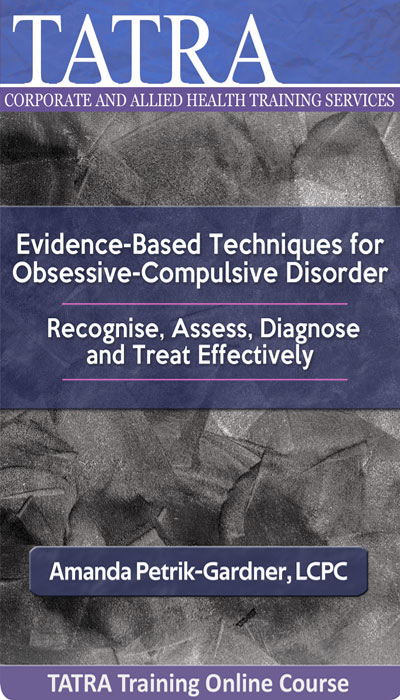15 Jul Evidence-Based Techniques for Obsessive-Compulsive Disorder: Recognise, Assess, Diagnose and Treat Effectively

Obsessive-Compulsive disorder (OCD) is an anxiety disorder that affects up to 3% of the population (more than 500,000 Australians). It usually begins in late childhood or early adolescence.
People with OCD experience recurrent and persistent thoughts, images or impulses that are intrusive and unwanted (obsessions). They also perform repetitive and ritualistic actions that are excessive, time-consuming and distressing (compulsions). People with OCD are usually aware of the irrational and excessive nature of their obsessions and compulsions. However, they feel unable to control their obsessions or resist their compulsions.
Obsessive-Compulsive Disorder (OCD) is often misdiagnosed, due to the stigma that OCD is solely about being “clean” and “organized.”
This online recording will assist participants in
- Identifying and diagnosing OCD
- Recognizing common themes such as
- Harm OCD
- Sexual Orientation OCD
- Religious/Scrupulosity OCD
- Existential OCD
- Relationship OCD, and more
Join us in learning the evidence-based treatment, Exposure & Response Prevention (ERP), over the course of two days. Participants will learn how to apply ERP to all OCD themes.


- Name the diagnosis and criteria of obsessive-compulsive disorder, and be able to recognize it in a client.
- Identify five different OCD themes.
- Identify five possible OCD compulsions.
- Describe the difference between “Taboo Thoughts” OCD versus suicidal or homicidal feelings.
- Differentiate between OCD and Obsessive-Compulsive Personality Disorder.
- Describe the rationale behind the evidence-based Exposure & Response Prevention as the most effective Exposure & Response Prevention.
- State the process of habituation.
- Identify possible exposure examples for any OCD theme.
- Practice using a Response Prevention Plan in order to decrease compulsions.
- Create a hierarchy of exposures for a client with OCD.
- Complete a Practice Record for an imaginal OCD case.
- Name at least one way to troubleshoot situations when Exposure & Response Prevention does not appear to be working.

 Amanda Petrik-Gardner (LCPC) is an Accredited Clinical Professional Counsellor in the State of Kansas, USA. She specializes in the treatment of Obsessive-Compulsive Disorder, Body-Focused Repetitive Behaviours, Body Focused Repetitive Behaviours like Trichotillomania (hair pulling disorder) and Excoriation (skin picking disorder), Body Dysmorphic Disorder, and other Anxiety Disorders.
Amanda Petrik-Gardner (LCPC) is an Accredited Clinical Professional Counsellor in the State of Kansas, USA. She specializes in the treatment of Obsessive-Compulsive Disorder, Body-Focused Repetitive Behaviours, Body Focused Repetitive Behaviours like Trichotillomania (hair pulling disorder) and Excoriation (skin picking disorder), Body Dysmorphic Disorder, and other Anxiety Disorders.
Amanda completed her Bachelor of Arts in Psychology from Kansas State University and her Master of Science in Counselling Psychology from the University of Kansas. Amanda is a member of the International OCD Foundation where she completed the Behavioural Therapy Training Institute. She is a member of the TLC Foundation for BFRBs where she completed the Virtual Professional Training Institute. Amanda is also a board member of OCD Kansas, an affiliate of the International OCD Foundation.

This online workshop will give you instant access to 11 hours of video content, accessible via streaming on our website, as well as downloadable PowerPoint slides (PDF). You can view the course content in your own time, there is no time limit on access.
The duration of this workshop is 11 learning hours. A certificate of completion will be generated upon finishing the course and completing a short evaluation quiz. Please consult your professional organisation/association to confirm whether you are able to claim any CPD points/hours for this online workshop.



